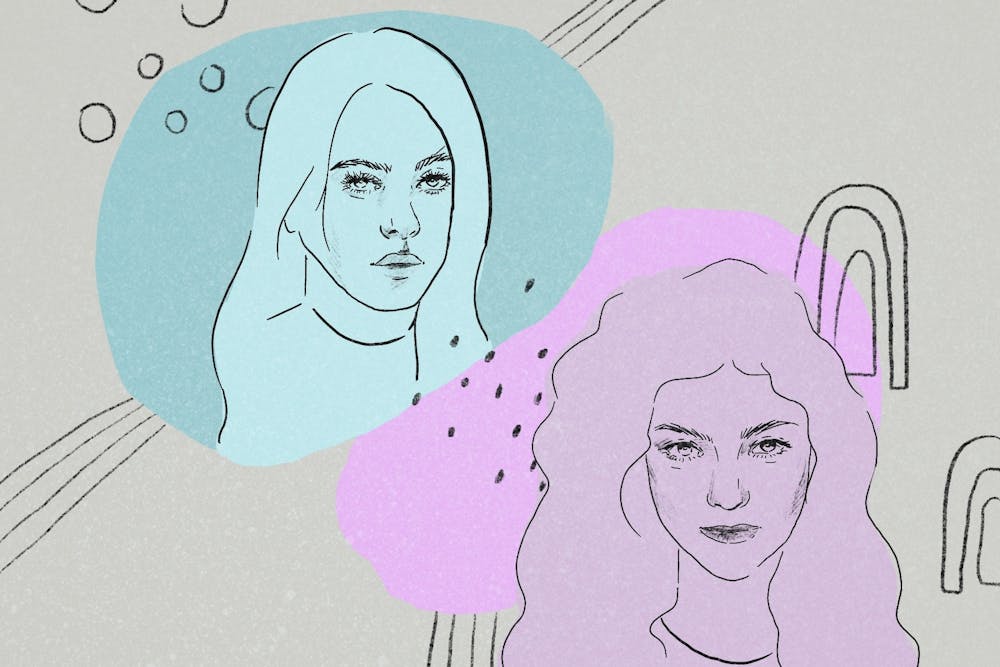Billie Eilish is inescapable. Since releasing her debut album, WHEN WE ALL FALL ASLEEP, WHERE DO WE GO?, less than a year ago, Eilish's rise to fame has been stratospheric. Eilish became a six–time Grammy recipient and the subject of a meme all before she could legally vote. The constant media attention she receives leads to hot takes, think pieces, and comparisons to other artists—namely, Lorde, the teen alt–rock star that came before her.
It’s easy to group artists together based on their identities rather than their music. Tegan and Sara and Sleater–Kinney feature two queer women who play guitar and keyboards. Marshmello and deadmau5 make beats from under a decorative mask. And Billie Eilish and Lorde are quirky teenage girls.
There are some similarities between them—both released an LP before they turned 18, and when “Bad Guy” dethroned “Old Town Road” on the Billboard charts, Eilish became the youngest artist to hit #1 since Lorde, with “Royals.” Their public images are self–designed, not the product of managers and publicists, from Lorde’s signature unchoreographed dancing to Eilish’s baggy clothes, which were designed to prevent public commentary on her body.
Additionally, both women have a neurological condition called synesthesia—Lorde perceives colors when she hears certain sounds and Eilish told Rolling Stone that "[e]very person I know has their own color and shape and number in my head."
The artists' songwriting processes also bear similarities. Lorde told Vice she "didn't really have a specific sound in mind" for her debut album Pure Heroine, but that she "always listened to hip–hop and electronic music, and also full–on top 40 pop." Eilish's brother Finneas O'Connell, meanwhile, told Vox, "We’re listening to everything—all genres, new music, old music, and it all just gets sort of synthesized and boiled down into a broth that we make."
That end product is where they differ. Whether paired with the minimalist, droning backgrounds of Pure Heroine or the orchestral, epic instrumentals on 2017 follow–up album Melodrama, Lorde's music always centers on her voice. Lorde told Vice, "I don't play any instruments, so my voice needs to have the focus. My vocal–scape is really important."
By contrast, Eilish's voice, thinner and softer than her supposed predecessor's, is often the least interesting thing about her music, which is crowded with synths, trap beats, and other gimmicks. The closest she comes to sounding like Lorde is on the Bond theme "No Time to Die," which trades synth beats and drum machines for a haunting piano line.
Lorde is to thank, in part, for Billie Eilish's success. Before "Royals" and Pure Heroine, young female musicians often fell into one of two categories: squeaky–clean, family–friendly pop stars imported from children's television, or former Disney Channel stars itching to break out of their G–rated personas. Miley Cyrus twerked with Robin Thicke at the VMAs a month before the release of Pure Heroine, and the controversial performance aligned with the established path to stardom, much like Britney Spears' albino python performance and Ariana Grande's post–Victorious career.
So many pop starlets' careers followed a precise trajectory: establish an image, establish an audience, then establish "maturity." Lorde, meanwhile, simply appeared. She sang. She danced—awkwardly. Through this, she generated a fan base. Sure, Melodrama was something of a departure from her first LP, but her image remained the same: the young woman who gave no fucks, wore all–black, grew her curly hair out, and wanted to focus simply on her voice, her lyrics, and her music.
Eilish is showier, in many ways, than Lorde. Her public fashion choices are brighter and have garnered more attention, and her music videos feature more than just Eilish singing into the camera. Even when she does sing into the camera, there's an added gimmick: a nosebleed smeared over her cheeks, ink dripping from her eyes like tears. Yet, at no point do these decisions feel like they came from a studio executive or the results of a focus group. Everything Eilish does, she does because she wants to do, and it was through Lorde's unabashed, genuine weirdness any teenage girl was able to follow her vision.
It's attractive, for the media narrative, if Billie Eilish is Lorde's direct successor, if a through line can be established from one socially awkward teenager to another. That way, the alternative adolescent of the year can be designated and pigeonholed accordingly. Cardi B and Nicki Minaj can't coexist, because there's only room for one queen of rap.
When Eilish grows a few years older, or hands over her title to another young ingenue, she will fade into obscurity, because the niche created for her was not one based on her music, but on a transient identity of the weird teenage girl.
Billie Eilish is not the new Lorde. To suggest as much hurts both artists. For Lorde, it implies she has been replaced. For Eilish, her music becomes less unique when she has a direct predecessor. These comparisons strip Lorde and Eilish of their individuality, the most important feature of their music. They must be appreciated for who they are, not who they might resemble. Otherwise, when another husky–voiced alt–rock adolescent releases her debut, she will be reduced to "the next Billie Eilish."







